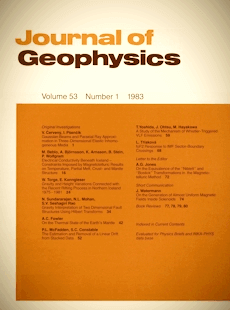Observation of gravity changes during the passage of cold fronts
Article Sidebar
Published:
Jul 28, 1983
Keywords:
Gravity changes,
Cold front,
Seismic noise
Volumes

Vols. 1-18 (1924-1944), ISSN 0044-2801
Main Article Content
T. Muller
Geophysical Institute, University of Karlsruhe, Germany
W. Zurn
Geophysical Institute, University of Karlsruhe, Germany
Abstract
Clear observations of small but abrupt changes in gravity during the passage of cold fronts are reported. Instrumental effects can be ruled out by special experiments. Simple models for the atmosphere show that the direction and the order of magnitude of the observed effects can be explained by changes in gravitational attraction of the sensor mass by the atmosphere or by downward acceleration of the ground due to the increasing air pressure. This is additional evidence for the high importance of meteorological causes for long-period seismic noise.
 ARK: https://n2t.net/ark:/88439/y040712
ARK: https://n2t.net/ark:/88439/y040712
Permalink: https://geophysicsjournal.com/article/143
Article Details
How to Cite
Section
References
Agnew, D.C., Berger, J., Buland, R., Farrell, W., Gilbert, F. (1976) IDA network for very long period seismology. EOS (Trans. Am. Geophys. Un.) 57:180-188
Agnew, D.C. (1979) Strain tides at pifion Flat: analysis and interpretation. Ph. D. Thesis, University of California at San Diego
Bath, M. (1982) Atmospheric waves from Mount St. Helens. EOS (Trans. Am. Geophys. Un.) 63:193
Block, B., Moore, R.D. (1966) Measurements in the Earth mode frequency range by an electrostatic sensing and feedback gravimeter. J. Geophys. Res. 71:4361-4375
Bolt, B.A., Tanimoto, T. (1981) Atmospheric oscillations after the May 18, 1980 eruption of Mount St. Helens. EOS (Trans. Am. Geophys. Un.) 62:529
Erdelyi, A., Magnus, W., Oberhettinger, F., Tricomi, F.G. (1954) Tables of integral transforms, Vol. I. McGraw-Hill, New York
Grose-Brauckmann, W. (1979) Untersuchungen der Bodenunruhe im Periodenbereich von 2 min-1 h mit dem Askania Bohrlochneigungsmesser. Ph.D. Thesis, Clausthal Tech. University
Heil, E. (1983) Erfahrungen mit einem Vertikalextensometer im Observ. Schiltach. Ph.D. Thesis, Karlsruhe University
Herbst, K. (1976) Interpretation von Neigungsmessungen im Periodenbereich oberhalb der Gezeiten. Ph.D. Thesis, Clausthal Tech. University
Kisslinger, C. (1960) Seismograms associated with the near passage of tornados. J. Geophys. Res. 65:721-728
Liljequist, G.H., Cehak, K. (1979) Allgemeine Meteorologie, 385 pp., Vieweg und Sohn, Braunschweig
Malzer, H. (1976) The Observatory. In: Szadeczky-Kardoss (Ed.) Proc. Seventh Int. Symposium Earth Tides, 725-727, Schweizerbart'sche Verlagsbuchhandlung, Stuttgart
Muller, T. (1981) Die Untersuchung von langperiodischen Schweresignalen beim Durchzug von Wetterfronten. Diploma Thesis, Karlsruhe University
Nakanishi, K.K., Knopoff, L., Slichter, L.B. (1976) Observation of Rayleigh wave dispersion at very long periods. J. Geophys. Res. 81:4417-4421
Ritsema, A.R. (1980) Observation of St. Helens eruption. EOS (Trans. Am. Geophys. Un.) 61:1201
Slichter, L.B., Zurn, W., Syrstad, E., Knopoff, L., Smythe, W.D., Uffelman, H. (1979) Long period gravity tides at the South Pole. J. Geophys. Res. 74:6207-6212
Sorrells, G.G. (1971) A preliminary investigation into a relationship between long-period seismic noise and local fluctuations in the atmospheric pressure field. Geophys. J. R. Astron. Soc. 26:71-82
Sorrels, G.G., McDonald, J.A., Der, Z.A., Herrin, E. (1971) Earth motion caused by local atmospheric pressure changes. Geophys. J. R. Astron. Soc. 26:83-98
Spratt, R.S. (1982) Modelling the effect of atmospheric pressure variations on gravity. Geophys. J. R. Astron. Soc. 71:173-186
Warburton, R.J., Goodkind, J.M. (1977) The influence of barometric-pressure variations on gravity. Geophys. J. R. Astron. Soc. 48:281-292
Wielandt, E., Streckeisen, G. (1982) The leaf-spring seismometerdesign and performance. Bull. Seismol. Soc. Am. 72A:2349-2368
Ziolkowski, A. (1973) Prediction and suppression of long-period non-propagating seismic noise. Bull. Seismol. Soc. Am. 63:937-958
Zschau, J. (1979) Air pressure induced tilt in porous media. In: Bonatz, Melchior (Eds.) Proc. Eighth Int. Symp. Earth Tides, pp. 418-433, Bonn
Agnew, D.C. (1979) Strain tides at pifion Flat: analysis and interpretation. Ph. D. Thesis, University of California at San Diego
Bath, M. (1982) Atmospheric waves from Mount St. Helens. EOS (Trans. Am. Geophys. Un.) 63:193
Block, B., Moore, R.D. (1966) Measurements in the Earth mode frequency range by an electrostatic sensing and feedback gravimeter. J. Geophys. Res. 71:4361-4375
Bolt, B.A., Tanimoto, T. (1981) Atmospheric oscillations after the May 18, 1980 eruption of Mount St. Helens. EOS (Trans. Am. Geophys. Un.) 62:529
Erdelyi, A., Magnus, W., Oberhettinger, F., Tricomi, F.G. (1954) Tables of integral transforms, Vol. I. McGraw-Hill, New York
Grose-Brauckmann, W. (1979) Untersuchungen der Bodenunruhe im Periodenbereich von 2 min-1 h mit dem Askania Bohrlochneigungsmesser. Ph.D. Thesis, Clausthal Tech. University
Heil, E. (1983) Erfahrungen mit einem Vertikalextensometer im Observ. Schiltach. Ph.D. Thesis, Karlsruhe University
Herbst, K. (1976) Interpretation von Neigungsmessungen im Periodenbereich oberhalb der Gezeiten. Ph.D. Thesis, Clausthal Tech. University
Kisslinger, C. (1960) Seismograms associated with the near passage of tornados. J. Geophys. Res. 65:721-728
Liljequist, G.H., Cehak, K. (1979) Allgemeine Meteorologie, 385 pp., Vieweg und Sohn, Braunschweig
Malzer, H. (1976) The Observatory. In: Szadeczky-Kardoss (Ed.) Proc. Seventh Int. Symposium Earth Tides, 725-727, Schweizerbart'sche Verlagsbuchhandlung, Stuttgart
Muller, T. (1981) Die Untersuchung von langperiodischen Schweresignalen beim Durchzug von Wetterfronten. Diploma Thesis, Karlsruhe University
Nakanishi, K.K., Knopoff, L., Slichter, L.B. (1976) Observation of Rayleigh wave dispersion at very long periods. J. Geophys. Res. 81:4417-4421
Ritsema, A.R. (1980) Observation of St. Helens eruption. EOS (Trans. Am. Geophys. Un.) 61:1201
Slichter, L.B., Zurn, W., Syrstad, E., Knopoff, L., Smythe, W.D., Uffelman, H. (1979) Long period gravity tides at the South Pole. J. Geophys. Res. 74:6207-6212
Sorrells, G.G. (1971) A preliminary investigation into a relationship between long-period seismic noise and local fluctuations in the atmospheric pressure field. Geophys. J. R. Astron. Soc. 26:71-82
Sorrels, G.G., McDonald, J.A., Der, Z.A., Herrin, E. (1971) Earth motion caused by local atmospheric pressure changes. Geophys. J. R. Astron. Soc. 26:83-98
Spratt, R.S. (1982) Modelling the effect of atmospheric pressure variations on gravity. Geophys. J. R. Astron. Soc. 71:173-186
Warburton, R.J., Goodkind, J.M. (1977) The influence of barometric-pressure variations on gravity. Geophys. J. R. Astron. Soc. 48:281-292
Wielandt, E., Streckeisen, G. (1982) The leaf-spring seismometerdesign and performance. Bull. Seismol. Soc. Am. 72A:2349-2368
Ziolkowski, A. (1973) Prediction and suppression of long-period non-propagating seismic noise. Bull. Seismol. Soc. Am. 63:937-958
Zschau, J. (1979) Air pressure induced tilt in porous media. In: Bonatz, Melchior (Eds.) Proc. Eighth Int. Symp. Earth Tides, pp. 418-433, Bonn











